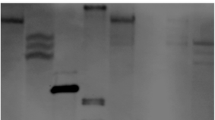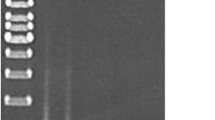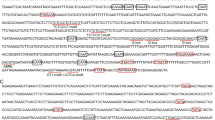Abstract
In order to identify important promoter elements controlling the ammonium-regulated expression of the soybean gene GS15 encoding cytosolic glutamine synthetase, a series of 5′ promoter deletions were fused to the GUS reporter gene. To allow the detection of positive and negative regulatory elements, a series of 3′ deletions were fused to a −90 CaMV 35S promoter fragment placed upstream of the GUS gene. Both types of construct were introduced into Lotus corniculatus plants and soybean roots via Agrobacterium rhizogenes-mediated transformation. Both spectrophotometric enzymatic analysis and histochemical localization of GUS activity in roots, root nodules and shoots of transgenic plants revealed that a strong constitutive positive element (SCPE) of 400 bp, located in the promoter distal region is indispensable for the ammonium- regulated expression of GS15. Interestingly, this SCPE was able to direct constitutive expression in both a legume and non- legume background to a level similar to that driven by the CaMV 35S full-length promoter. In addition, results showed that separate proximal elements, located in the first 727 bp relative to the transcription start site, are essential for root- and root nodule-specific expression. This proximal region contains an AAAGAT and two TATTTAT consensus sequences characteristic of nodulin or nodule-enhanced gene promoters. A putative silencer region containing the same TATTTAT consensus sequence was identified between the SCPE and the organ-specific elements. The presence of positive, negative and organ-specific elements together with the three TATTTAT consensus sequences within the promoter strongly suggest that these multiple promoter fragments act in a cooperative manner, depending on the spatial conformation of the DNA for trans-acting factor accessibility.
Similar content being viewed by others
References
Andersson CR, Llewellyn DJ, Peacock WJ, Dennis ES: Cellspecific expression of the promoters of two non-legume hemoglobin genes in a transgenic legume, Lotus corniculatus. Plant Physiol 113: 45–57(1997).
Back E, Dunne W, Schneiderbaier A, de Framond A, Rastogi R, Rothstein S: Isolation of the spinach nitrite reductase promoter which confers nitrate inducibility on GUS gene expression in transgenic tobacco. Plant Mol Biol 17: 9–18 (1991).
Benfey PN, Chua NH: Regulated genes in transgenic plants. Science 244: 174–181(1989).
Benfey PN, Ren L, Chua NH: The CaMV 35S enhancer contains at least two domains which can confer different developmental and tissue-specific expression patterns. EMBO J 8: 2195–2202(1989).
Bradford MM: A rapid and sensitive method for the quantitation of microgram quantities of protein utilizing the principle of protein-dye binding. Anal Biochem 72: 248–254(1976).
Bustos MM, Guiltinan MJ, Jordano J, Begum D, Kalkan FA, Hall TC: Regulation of β-glucuronidase expression in transgenic tobacco plants by an A/T rich, cis-acting sequence found upstream of a french bean β-phaseolin gene. Plant Cell 1: 839–853(1989).
Calza R, Huttner E, Vincentz M, Rouzé P, Galangai F, Vaicheret H, Cherel I, Meyer C, Caboche M: Cloning DNA fragments complementary to tobacco nitrate reductase mRNA and encoding epitopes common to the nitrate reductase of higher plants. Mol Gen Genet 209: 552–562(1987).
Carrayol E, Tercé-Laforgue T, Desbrosses G, Pruvot-Maschio G, Poirier S, Ratet P, Hirel B: Ammonia regulated expression of a soybean gene encoding cytosolic glutamine synthetase is not conserved in two heterologous plant systems. Plant Sci 125: 75–85(1997).
Castresana C, Garcia-Luque I, Alonso E, Malik VS, Cashmore AR: Both positive and negative elements mediate expression of a photoregulated CAB gene from Nicotiana plumbaginifolia. EMBO J 7: 1929–1936(1988).
Cheng CL, Acedo GN, Cristinsin M, Conkling MA: Sucrose mimics the light induction of Arabidopsis nitrate reductase gene transcription. Proc Natl Acad Sci USA 89: 1861–1864 (1992).
Cheon C, Lee NG, Siddique ABM, Bal AK, Verma DPS: Roles of plant homologs of Rab1p and Rab7p in the biogenesis of the peribacteroid membrane, a subcellular compartment formed de novo during root nodule symbiosis. EMBO J 12: 4125–4135(1993).
Coï c Y, Lesaint C: Comment assurer une bonne nutrition en eai et en ions minéraix en horticulture. Hort Franç 8: 11–14 (1971).
Coï c Y, Tendille J, Lesaint C: La nutrition azotée du tournesol (Helianthus annuus): Action sur le rendement et la composition biochimique de la graine. Agrochemica 16: 254–263 (1972).
Crawford NM, Campbell WH, Davis RW: Nitrate reductase from squash: cDNA cloning and nitrate regulation. Proc Natl Acad Sci USA 83: 8073–8076(1986).
Devereux J, Haeberli P, Smithies O: A comprehensive set of sequence analysis programs for the VAX. Nucl Acids Res 12: 387–395(1984).
Ditta G, Stanfiel S, Corbin D, Helinski DR: Broad host range DNA cloning system for Gram-negative bacteria: construction of a gene bank of Rhizobium meliloti. Proc Natl Acad Sci USA 77: 7347–7351(1980).
Espin G, Moreno S, Guzman J: Molecular genetics of the glutamine synthetases in Rhizobium species. Crit Rev Microbiol 20: 117–123(1994).
Fang RX, Nagy F, Sivasubramaniam S, Chua NH:Multiple cis-regulatory elements for maximal expression of the cailiflower mosaic virus 35S promoter in transgenic plants. Plant Cell 1: 147–150(1989).
Forchhammer K, Tandeai de Marsac N: Functional analysis of the phosphoprotein PII (glnβ gene product) in the Cyanobacterium Synechococcus sp. strain PCC 7942. J Bact 177: 2033–2040(1995).
Forde BG: A/T-rich elements (ATREs) in the promoter regions of nodulin and other higher plant genes: a novel class of cis-acting regulatory element? In: Nover L (ed) Plant Promoters and Transcription Factors, pp. 87–103. Springer-Verlag, Berlin/Heidelberg (1994).
Forde BG, Day HM, Turton JF, Wen-jun S, Cullimore JV, Oliver JE: Two glutamine synthetase genes from Phaseolus vulgaris L. display contrasting developmental and spatial patterns of expression in transgenic Lotus corniculatus plants. Plant Cell 1: 391–401(1989).
Forde BG, Freeman J, Oliver JE, Pineda M: Nuclear factors interact with conserved A/T-rich elements upstream of a nodule-enhanced glutamine synthetase gene from french bean. Plant Cell 2: 925–939(1990).
Gantt JS, Thompson MD: Plant cytosolic ribosomal protein S11 and chloroplast protein CS17. J Biol Chem 265: 2763–2767 2767(1990).
Hirel B, Bouet C, King B, Layzell D, Jacobs F, Verma DPS: Glutamine synthetase genes are regulated by ammonia provided externally or by symbiotic nitrogen fixation. EMBO J 6: 1167–1171(1987).
Hoff T, Truong H-N, Caboche M: The use of mutants and transgenic plants to study nitrate assimilation. Plant Cell Environ 17: 489–506(1994).
Horsh RB, Fraley RT, Rogers SG, Sanders PR, Lloyd A, Hoffmann N: Inheritance of functional foreign genes in plants. Science 223: 496–498(1984).
Hwang CF, Lin Y, D'souza T, Cheng CL: Sequences necessary for nitrate-dependent transcription of Arabidopsis nitrate reductase genes. Plant Physiol 113: 853–862(1997).
Jang JC, Leon P, Zhou L, Sheen J: Hexokinase as a sugar sensor in higher plants. Plant Cell 9: 5–19(1997).
Jefferson RA, Kavanagh TA, Bevan MW: GUS fusions: β-glucuronidase as a sensitive and versatile gene fusion marker in higher plants. EMBO J 6: 3901–3907(1987).
Koch KE:Molecular crosstalk and the regulation of C-and Nresponsive genes. In Foyer CH, Quick WP (eds) A Molecular Approach to Primary Metabolism in Higher Plants, pp. 105–124. Taylor and Francis, London (1997).
Kosugi S, Ohashi Y, Nakajima K, Arai Y: An improved assay for _-glucuronidase in transformed cells: methanol almost completely suppresses a putative endogenous β-glucuronidase activity. Plant Sci 70: 133–140(1990).
Kozaki A, Sakamoto A, Takeba G: The promoter of the gene for plastidic glutamine synthetase (GS2) from rice is developmentally regulated and exhibits substrate-induced expression in transgenic tobacco plants. Plant Cell Physiol 33: 233–238 (1992).
Kozaki A, Sakamoto A, Tanaka K, Takeba G: The promoter of the gene for glutamine synthetase from rice shows organspecificity and substrate-induced expression in transgenic tobacco plants. Plant Cell Physiol 32: 353–358(1991).
Kronenberger J, Lepingle A, Caboche M, Vaicheret H: Cloning and expression of distinct nitrite reductases in tobacco leaves and roots. Mol Gen Genet 236: 203–208(1993).
Lam HM, Coschigano K, Schultz C, Melo-Oliveira R, Tjaden G, Oliveira I, Ngai N, Hsieh MH, Coruzzi G: Use of Arabidopsis mutants and genes to study amide amino-acid biosynthesis. Plant Cell 7: 887–898(1995).
Macknight RC, Reynolds PHS, Farnden KJF: Analysis of the lupin Nodulin-45 promoter: conserved regulatory sequences are important for promoter activity. Plant Mol Biol 27: 457–465 (1995).
Maniatis T, Fritsch EF, Sambrook J: Molecular Cloning: A Laboratory Manual. Cold Spring Harbor Laboratory Press, Cold Spring Harbor, NY (1982).
Marsolier MC, Carrayol E, Hirel B: Multiple functions of promoter sequences involved in organ-specific expression and ammonia regulation of a cytosolic glutamine synthetase gene in transgenic Lotus corniculatus. Plant J 3: 405–414(1993).
Marzluf GA: Genetic regulation of nitrogen metabolism in the fungi. Microbiol Mol Biol Rev 61: 17–32(1997).
Miao GH, Hirel B, Marsolier MC, Ridge RW, Verma DPS: Ammonia-regulated expression of a soybean gene encoding cytosolic glutamine synthetase in transgenic Lotus corniculatus. Plant Cell 3: 11–22(1991).
Müller M, Knudsen S: The nitrogen response of a barley C-hordein promoter is controlled by positive and negative regulation of the GCN4 and endosperm box. Plant J 4: 343–355 (1993).
Murashige J, Skoog F: A revised medium for rapid growth and bioassay with tobacco tissue culture. Physiol Plant 115: 473–497(1962).
Petit A, Stougaard J, Kühle A, Marcker KA, Tempé J: Transformation and regeneration of the legume Lotus corniculatus: a system for molecular studies of symbiotic nitrogen fixation. Mol Gen Genet 207: 245–250(1987).
Quesada A, Krapp A, Trueman LJ, Daniel-Vedèle F, Fernandez E, Forde BG, Caboche M: PCR identification of a Nicotiana plumbaginifolia cDNA homologue to the high affinity nitrate transporters of the crnA family. Plant Mol Biol 34: 265–274(1997).
Sandal NN, Bojsen K, Marcker KA: A small family of nodule specific genes from soybean. Nucl Acids Res 15: 1507–1519 (1987).
Scheible WR, Gonzalez-Fontes A, Laierer M, Müller-Röber B, Caboche M, Stitt M: Nitrate acts as a signal to induce organic acid metabolism and repress starch metabolism in tobacco. Plant Cell 9: 783–798(1997).
She Q, Sandal NN, Stougaard J, Marcker KA: Comparative sequence analysis of cis elements present in Glycine max L. leghemoglobin lba and lbc3 genes. Plant Mol Biol 22: 931–935 (1993).
Sheen J: Metabolic repression of transcription in higher plants. Plant Cell 2: 1027–1038(1990).
Shen W, Williamson MS, Forde BG: Functional analysis of the promoter region of a nodule-enhanced glutamine synthetase gene from Phaseolus vulgaris L. Plant Mol Biol 19: 837–846 (1992).
Stougaard J, Jorgenson JE, Christensen T, Kühle A, Marcker KA:Interdependence and nodule specificity of cis-acting regulatory elements in the soybean leghemoglobin lbc3 and N23 gene promoters. Mol Gen Genet 220: 353–360(1990).
Sugiharto B, Sugiyama T: Effects of nitrate and ammonium on gene expression of phosphoenolpyruvate carboxylase and nitrogen metabolism in maize leaf tissue during recovery from nitrogen stress. Plant Physiol 98: 1403–1408(1992).
Sukanya R, Li M, Snustard PD: Root-and shoot-specific response of individual glutamine synthetase genes of maize to nitrate and ammonium. Plant Mol Biol 26: 1935–1946(1994).
Szczyglowski K, Szabados L, Fujimoto S, Silver D, de Bruijn FJ: Site-specific mutagenesis of the nodule-infected cell expression (NICE) element and the AT-rich ATRE-BS2 of the Sesbania rostrata leghemoglobin glb3 promoter. Plant Cell 6: 317–332(1994).
Thykjæ r T, Danielsen D, She Q, Stougaard J: Organization and expression of genes in the genomic region surrounding the glutamine synthetase gene Gln1 from Lotus japonicus. Mol Gen Genet 255: 628–636(1997).
Tjaden G, Coruzzi M: A novel AT-rich DNA binding protein that combines an HMG I-like DNA binding domain with a putative transcription domain. Plant Cell 6: 107–118(1994).
Tjaden G, Edwards JW, Coruzzi GM: cis elements and transacting factors affecting regulation of a nonphotosynthetic light-regulated gene for chloroplast glutamine synthetase. Plant Physiol 108: 1109–1117(1995).
Tumer NE, Robinson SJ, Haselkorn R: Different promoters for the Anabaena glutamine synthetase gene during growth using molecular or fixed nitrogen. Nature 306: 337–342(1983).
Watson AT, Cullimore JV: Characterisation of the expression of the glutamine synthetase gln-α gene of the Phaseolus vulgaris using promoter-reporter gene fusions in transgenic plants. Plant Sci 120: 139–151(1996).
Woods R, Reid SH: Recent developments on the regulation and structure of glutamine synthetase enzymes from selected bacterial groups. FEMS Microbiol Rev 11: 273–284(1993).
Wray JL: Molecular biology, genetics and regulation of nitrite reduction in higher plants. Physiol Plant 89: 607–612(1993).
Wray LV, Ferson AE, Rohrer K, Fisher SH: TnrA, a transcription factor required for global nitrogen regulation in Bacillus subtilis. Proc Natl Acad Sci USA 93: 8841–8845(1996).
Author information
Authors and Affiliations
Rights and permissions
About this article
Cite this article
Tercé-laforgue, T., Carrayol, E., Cren, M. et al. A strong constitutive positive element is essential for the ammonium-regulated expression of a soybean gene encoding cytosolic glutamine synthetase. Plant Mol Biol 39, 551–564 (1999). https://doi.org/10.1023/A:1006169018296
Issue Date:
DOI: https://doi.org/10.1023/A:1006169018296




